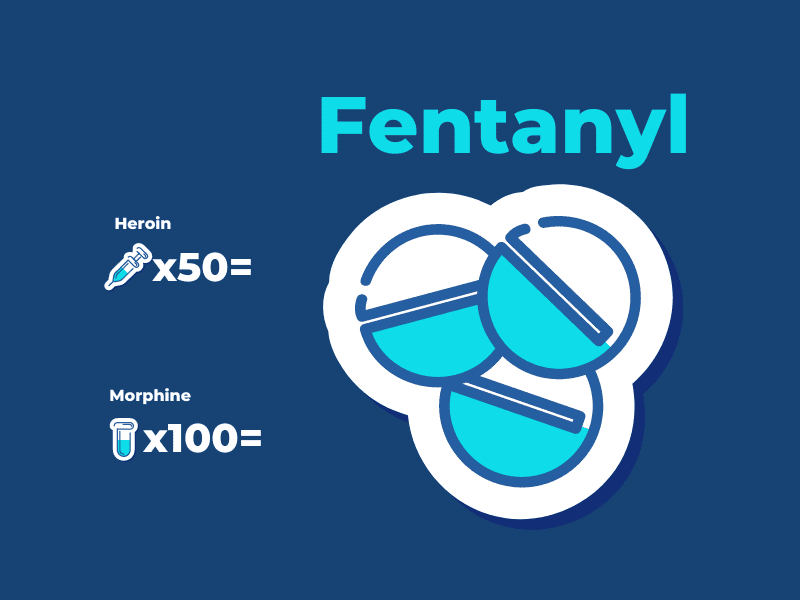Teen Fentanyl Addiction Treatment & Rehab
Use this resource page to explore different fentanyl addiction treatment options that are right for your teen.
Fentanyl is a powerful synthetic opioid commonly compared to morphine but is 50 to 100 times more potent.
Although it is a prescription drug that may be used to treat patients with severe pain or chronic pain, it is also made and used illegally.
According to the National Institute on Drug Abuse, synthetic opioids, which include fentanyl, are the most common drugs involved in drug overdose deaths in the United States.
Fentanyl is highly addictive because it is so potent.
Even someone prescribed fentanyl can develop a dependence, which involves experiencing withdrawal symptoms when someone stops using a substance. Dependence is not the same as addiction; however, it can quickly lead to it.
Fentanyl is an extremely strong and powerful substance.
To put it in perspective, the CDC also reports that fentanyl is 50 times stronger than heroin and 100 times stronger than morphine. Substances can contain deadly amounts of fentanyl without a person being able to see it, smell it, or taste it.


Some teens may use fentanyl to feel “euphoric” or extremely happy.
However, its euphoric effects are only temporary and come with a number of negative effects. Fentanyl can make a person feel drowsy, confused, nauseous, and constipated.
When a person becomes addicted, the brain seeks the drug over and over again to feel “normal” again. Additionally, someone experiencing withdrawal may become agitated or depressed because of the changes in brain chemicals.
Someone who has been exposed to fentanyl or has become intoxicated may experience symptoms such as:
According to the U.S. Food and Drug Administration, accidental exposure to fentanyl patches can cause overdose and become fatal for kids.
The FDA highlights the need to store and dispose of it properly. Some people may be prescribed fentanyl patches for long-term pain medicine; however, it is extremely dangerous and deadly if a child gains access to it.
People who develop a dependence or addiction to fentanyl may experience withdrawal symptoms.
Symptoms can include:




The Continuum of Care
Access a full range of treatments for mental health and substance use disorders. Whether you need a safe transitional living community, inpatient care, or outpatient therapy, we have a program to help.
A teen who is using fentanyl or has an addiction may show signs such as:
Short-term effects of fentanyl addiction in teens can include:
Long-term effects of fentanyl use and addiction in teens can include:
It is common for mental disorders to co-occur with substance use disorders; however, it can make the treatment process more complex.
Some people struggling with mental health issues may turn to substances to self-medicate, and vice versa.
When considering treatment, it is important to identify and address each problem rather than treating it as one disorder.

Teen fentanyl addiction treatment can involve medication and behavioral therapies. Sandstone Care is here to support teens and young adults struggling with mental health and substance use disorders.
Signs your teen may need treatment for a fentanyl addiction may include:

The most common and effective treatment for teen fentanyl addiction involves a combination of medication with behavioral therapy.
Medications like buprenorphine and methadone can help reduce cravings and ease withdrawal symptoms. Naltrexone is another medication that can help prevent the effects of fentanyl.
For teens, it is important to talk about the safety of medications for teen addiction treatment use with their healthcare provider.
Therapy Treatments
We deliver evidence-based therapy treatment for teens in a number of areas. We’re available 24/7 to answer any questions.



4880 Sadler Rd, Suite 110, Glen Allen, Virginia, 23060
(888) 850-1890


FAQs
Our goal is to provide the most helpful information. Please reach out to us if you have any additional questions. We are here to help in any way we can.
Teens and young adults are at a higher risk of developing a fentanyl addiction. The brain is still undergoing major development throughout the teenage and young adult years.
This development, along with genetics and environmental factors, increases teens’ vulnerability to addiction.
Teens may obtain fentanyl by being prescribed it for severe pain. They may also get it from a friend or family member who was prescribed fentanyl.
Fentanyl is also illicitly made and sold and sometimes mixed with other substances without a person knowing, which can be extremely dangerous.
According to Anesthesia & Analgesia, a study showed that fentanyl could be detected in urine 24 hours after administration.
Additionally, hair tests can detect fentanyl for up to 3 months.
Fentanyl can be made in many different forms.
It can be sold illegally as a powder, which looks like many other drugs, and can be unnoticeable when combined with heroin or cocaine. It may also be made into pills to look like other prescription opioids.
Additionally, fentanyl can take the form of a liquid in nasal sprays, eye droppers, or blotter papers.
When fentanyl is illegally made and mixed with other substances, it can be extremely dangerous and result in overdose.
Signs of opioid overdose can include:
If you think someone may be experiencing an overdose, call 911 immediately.
It can sometimes be difficult for parents or loved ones to tell that their teen may be struggling with addiction.
Warning signs that a teenager may be addicted to drugs can include:
A teen who is struggling with addiction may also exhibit significant mood changes. They may be extremely irritable, agitated, paranoid, or have trouble concentrating or staying focused.
Many signs of substance abuse or addiction also show similarities with warning signs of mental health conditions. If you suspect your teen may be struggling with addiction or mental health, it is important to seek professional help to receive proper diagnosis and care.
According to the National Institute on Drug Abuse, biology, environment, and development are factors that put a person at risk of developing an addiction.
Teens and young people are especially vulnerable to addictive behaviors.
Many young people are faced with peer pressure and stressors and may be exposed to drugs during their teenage years.
Certain areas of the brain responsible for impulse control, decision-making, and judgment are still developing throughout a person’s teenage and young adult years, making teens more susceptible to risky behaviors like drug use.
Moreover, the earlier substance use begins, the more likely it is for the person to develop an addiction.